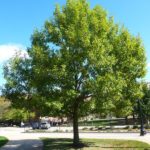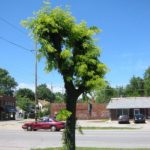Our office gets hundreds of questions each year regarding tree care, such as who should I get to prune or treat my trees and who should care for my trees around my home? This is a very important consideration for managing a valuable asset to your property. Value? Sure, trees provide shade and a place to sit during hot days and they also reduce heating and cooling bills, naturally clean the air and water, add oxygen and control noise levels. However, many homeowners don’t realize properly placed, maintained trees are attractive and increase property values by as much as 15%.
Unfortunately, we receive troubled callers who are left with the aftermath from hiring the “cheapest” tree trimmer or the untrained tree worker. Typically, they are left with the irreversible and often lethal damage from overaggressive pruning, topping or misapplications during plant health care treatments.
Who do you hire for your tree care work? Proper tree care by an International Society of Arboriculture Certified Arborist with a reputable company is an investment that results in positive returns. An arborist by definition is an individual who is trained in the art and science of planting, caring for, and maintaining individual trees. ISA arborist certification is a nongovernmental, voluntary process by which individuals can document their base of knowledge. Certified Arborists are individuals who have achieved a level of knowledge in the art and science of tree care through experience and by passing a comprehensive examination developed by some of the nation’s leading experts on tree care.
- Figure 1. A well-maintained tree provides value to your home
- Figure 2. Topping trees is unhealthy for trees and can be lethal
- Figure 3. Look for the Certified Arborist logo
When hiring someone for tree care, treat it the same as any other skilled profession such as an electrician, plumber or contractor. Do your homework. A few of the more important steps to help insure better care for your trees include:
- Confirm their credentials with the ISA on their website, www.treesaregood.org. Many companies claim to be credentialed “arborists” and will often advertise inaccurately. Check to be certain they are current with their certification.
- Verify proof of insurance to protect yourself. Tree maintenance is dangerous work and an uninsured tree care worker can make the homeowner liable for any injury. Be sure they have a current certificate of insurance.
- Inspect their work and ask for references. Would you allow someone to remodel your kitchen without a reference or seeing examples of their work? Certainly not! This is the easiest part of the process because their tree work can often be reviewed from the sidewalk.
This process doesn’t necessarily provide any guarantee, because all businesses are different, but it can provide assurances for better work and longer-lived trees. Maintained trees are attractive and add considerable value to your property. Poorly maintained trees can be a significant liability. Pruning or removing trees, especially large trees, can be dangerous work and should be done only by those trained and equipped to work safely in trees. Don’t just go by price alone, do some research or you’re gonna get what you pay for which may end up being even more costly and not just financially.
For more information on hiring an arborist, visit https://www.treesaregood.org/portals/0/docs/treecare/hire_arborist.pdf


